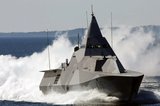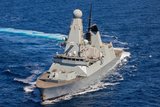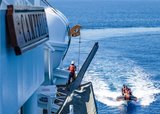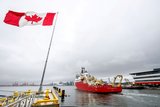Defence Insight Briefs: Naval modernisation accelerates amid geopolitical tension and tech evolution
Crewed and un-crewed systems team up to maintain a persistent eye in the naval domain.
Heightened concern over regional security — from the Red Sea to the North Atlantic — is reshaping naval priorities. The proliferation of aerial threats from actors such as the Houthis has revived investment in anti-air weapon systems.
Simultaneously, Russia’s enduring emphasis on its submarine fleet — especially its SSNs and improved Kilo-class platforms — has intensified demand for anti-submarine warfare (ASW) capabilities across the Atlantic and Mediterranean. This has placed ASW squarely at the centre of procurement strategies.
Countries such as the UK and Norway, which guard key maritime chokepoints such as the GIUK gap, have led the charge. Yet the challenge is complex.
Submarine detection and deterrence require a networked response spanning surface vessels, submarines and maritime patrol aircraft (MPA), all integrated through persistent surveillance and sensor fusion.
However, with limited hull numbers and ongoing personnel shortages across many navies, traditional platforms alone are no longer sufficient.
This shortfall is fuelling rapid interest in uncrewed systems. Mine countermeasures (MCM) have long relied on remotely operated vehicles (ROVs), but the adoption of uncrewed technologies is now expanding into broader domains, including ASW and ISR.
The UK’s Project CABOT is a standout initiative that aims to deliver a family of uncrewed systems capable of persistent ASW operations in the Atlantic.
The project will unfold in two phases: the initial stage will see contractor-owned and -operated platforms, with a transition to Royal Navy-operated assets in the longer term. CABOT builds on the earlier ASW Spearhead initiative and leverages systems such as Leonardo’s rotary-wing Proteus UAS and the BAE Systems Herneextra-large autonomous underwater vehicle (XLAUV).
These platforms are intended not to replace but to augment existing frigates, destroyers and submarines — forming a hybrid, teamed approach that reflects the realities of 21st-century naval warfare.
This trend is also visible in Europe, where collaboration is key. The Belgium-Netherlands MCM programme, executed in partnership with France’s Thales and Exail, exemplifies joint procurement. Vessels are being constructed in France and Romania, with uncrewed systems forming the operational core.
Notably, the motherships are designed to remain outside the minefield, controlling assets remotely. In contrast, Italy’s approach — using fibreglass-hulled motherships from Intermarine — allows optional crewed entry into contested zones, offering redundancy in electronically degraded environments.
Outside Europe, momentum is growing in the Middle East. Gulf states are prioritising localisation, leading to joint ventures such as Maestral (Fincantieri and EDGE Group), CMN Naval with EDGE, and Damen with Al Seer Marine.
Recent orders include ten offshore patrol vessels (OPVs) for the UAE Coast Guard, with follow-on vessels to be built regionally. These ventures signal a structural shift in how European firms engage with the region — pairing export success with local industry development.
Elsewhere, Singapore is charting its own path. Its new combatant-class drone motherships, built with ST Engineering, Saab and OMT, reflect a deliberate shift toward hybrid naval architecture. The city-state is also expanding its submarine fleet, adding two more Invincible-class boats based on the German Type 218 design.
Meanwhile, strategic defence initiatives such as NATO’s Baltic Sentry aim to bolster security in the face of asymmetric threats, including cable sabotage and undersea infrastructure interference — often attributed to Russia’s so-called “shadow fleet”. Here too, uncrewed systems will be instrumental in enabling round-the-clock surveillance and rapid response.
Although enthusiasm for uncrewed systems is widespread, traditional platforms remain indispensable. Frigates and submarines continue to anchor procurement plans across Europe. From Spain to Norway, navies are investing in proven hulls while integrating cutting-edge technology and multi-domain capabilities.
Ultimately, naval modernisation is becoming a collective endeavour. Joint development programmes — from minehunters to multirole uncrewed systems — not only spread the financial burden but also promote interoperability and doctrinal cohesion.
If Europe is to remain strategically relevant, it must lean into these synergies. Specialisation across services — with maritime nations like the UK playing a lead role at sea — could enhance both resilience and efficiency.
In a fragmented security landscape, navies are being asked to do more, often with less. The path forward lies in teaming — between crewed and uncrewed systems, and between nations themselves.
Related Equipment in Defence Insight
More from Naval Warfare
-
![Sweden’s decision on four new warships inches closer as it eyes UK, France and Spain]()
Sweden’s decision on four new warships inches closer as it eyes UK, France and Spain
Sweden decided last year that it wanted a significantly larger warship for its Luleå Class programme than originally planned, with three likely contenders that could potentially deliver within the country’s tight schedule.
-
![US Coast Guard prepares procurement of next-gen surface search radar]()
US Coast Guard prepares procurement of next-gen surface search radar
The NXSSR will replace five in-service capabilities and be the US Coast Guard’s primary collision avoidance system.
-
![MBDA-led DragonFire’s latest trials move the LDEW system closer to UK Navy integration]()
MBDA-led DragonFire’s latest trials move the LDEW system closer to UK Navy integration
The DragonFire lines up with other European laser-directed energy weapons being developed in collaboration with MBDA.
-
![US Coast Guard pursues solutions to increase maritime domain dominance]()
US Coast Guard pursues solutions to increase maritime domain dominance
The USCG is seeking technologies, services and applications to better connect its assets and speed up the decision-making process.
-
![Canadian Coast Guard’s OOSV delivery is “major milestone” in fleet modernisation]()
Canadian Coast Guard’s OOSV delivery is “major milestone” in fleet modernisation
The Polar Class 6 platform is the largest CCG science-dedicated vessel and will operate on the country’s east coast.






















